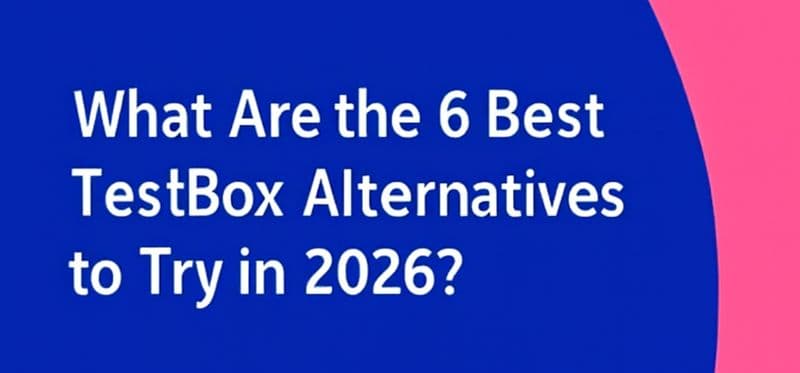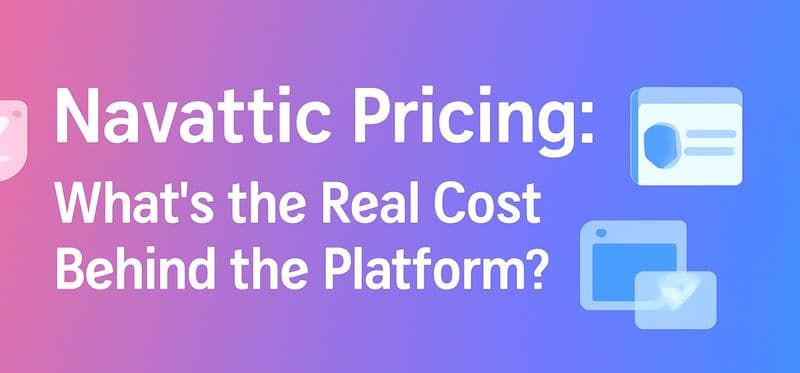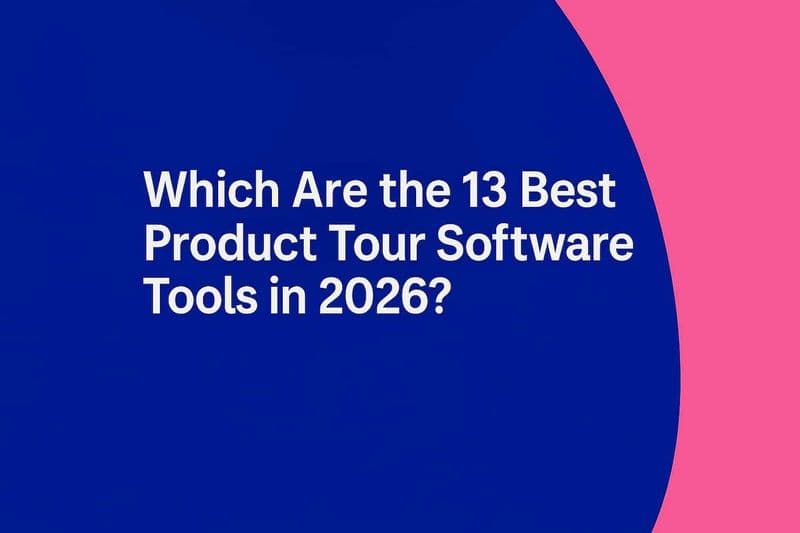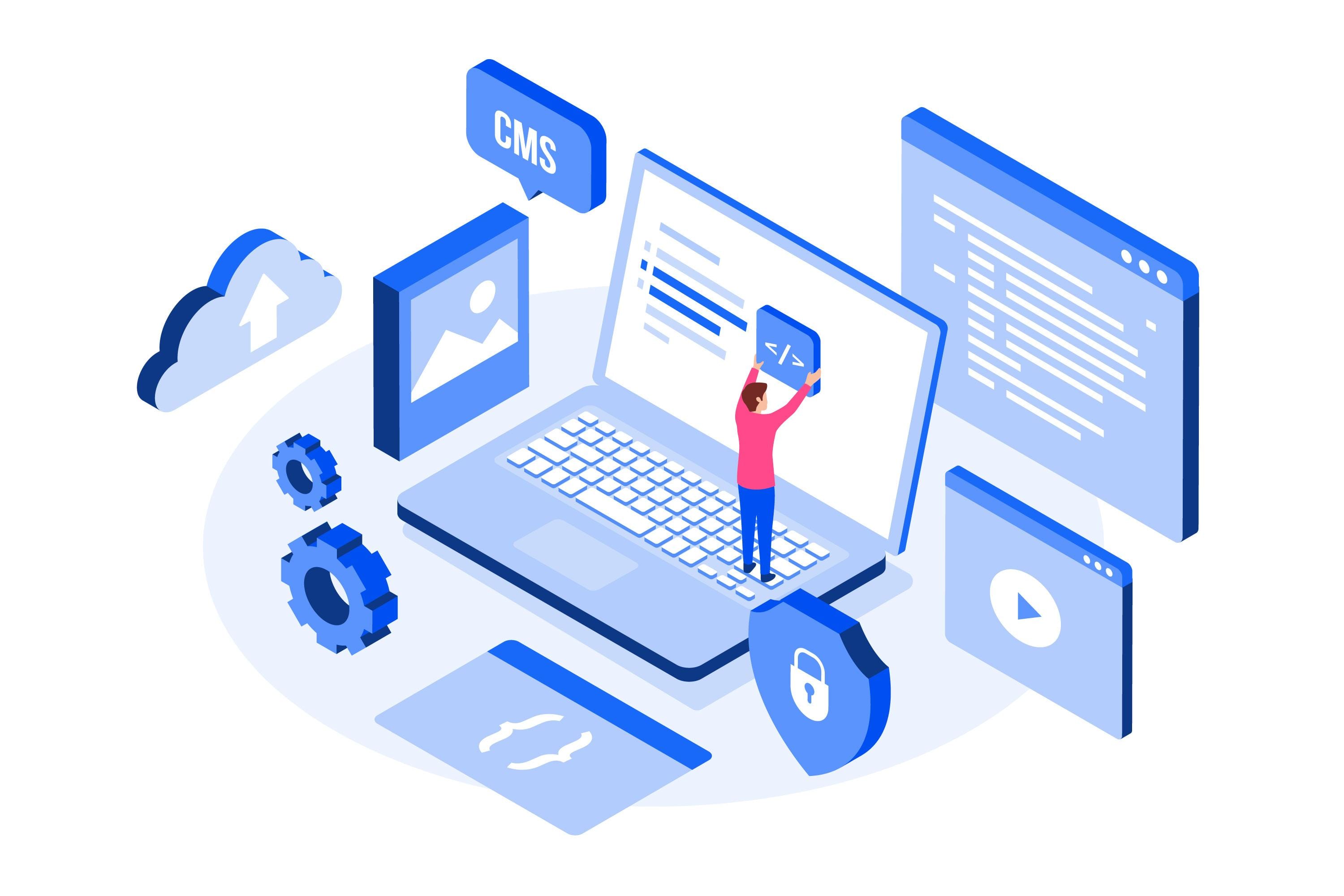
Sales teams today face more pressure than ever to deliver meaningful, efficient customer experiences—but many are still held back by disjointed tools, outdated content, and training that fails to connect. The result? Missed opportunities and conversations that fall flat.
That’s starting to shift—quickly.
Organizations are now prioritizing smarter enablement strategies that align sales and marketing around real buyer needs. Leaders are building resources that are timely, personalized, and built to support genuine customer conversations, not just check boxes.
With AI and automation handling the repetitive tasks, sales teams are freed up to focus on what matters: building relationships and closing deals.
In this article, we’ll break down the latest trends reshaping sales enablement and what it takes to build a strategy that actually drives results in 2025.
What Is Sales Enablement?
Sales enablement is the strategic engine that powers high-performing sales teams. It’s all about giving sellers what they need—content, tools, data, and training—so they can confidently engage today’s hyper-informed buyers. More than just handing over a few resources, the sales enablement function creates a system that connects marketing and sales, ensures consistency, and drives measurable sales success results.
And in a world where buyer behaviors change as fast as your latest app update, that kind of structure isn’t optional—it’s essential.
So, what does great sales enablement actually look like?
A toolkit that works harder than your inbox: From playbooks to pitch decks, reps get exactly what they need, when they need it—no digging required.
Sales and marketing, finally speaking the same language: It aligns both teams so content isn’t just pretty—it’s purposeful and ready to use.
Training that doesn’t put people to sleep: Continuous learning integrated into daily work that keeps reps sharp, engaged, and ready to tackle new buyer expectations, especially for new hires.
Analytics that tell the real story: Insights that show what’s working, what’s not, and where to double down for results.
Custom strategies that fit like a glove: Because sales enablement best practices aren’t plug-and-play—they need to reflect your market, your team, and your goals.
Leadership that owns the mission: A dedicated sales enablement leader to keep the vision alive, refine strategy, and guide the ship through shifting market dynamics.
Sales enablement isn’t a buzzword. It’s how modern organizations sell smarter, move faster, and stay ahead.
10 Major Sales Enablement Trends to Watch In 2025
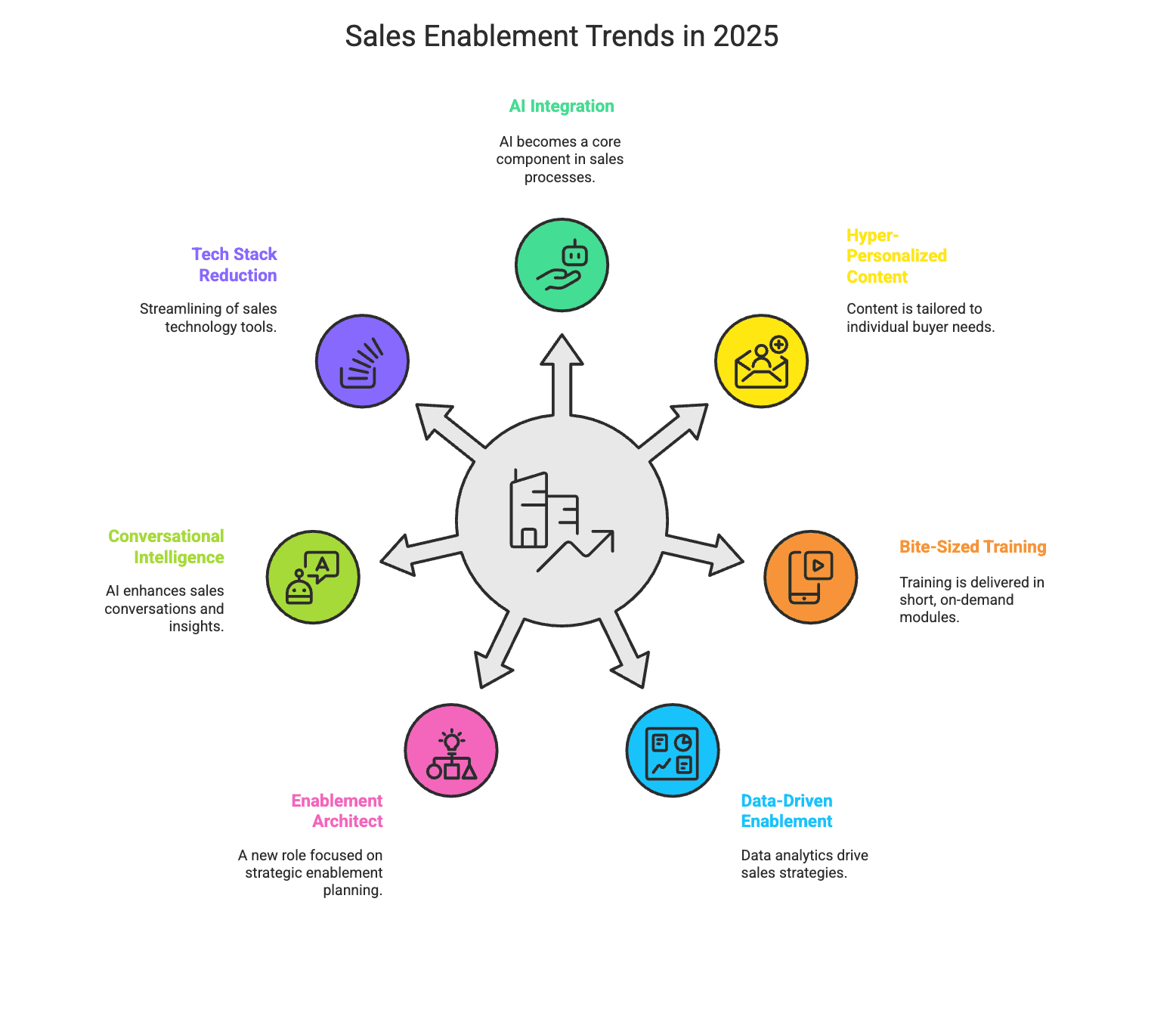
With sales enablement evolving consistently, it becomes crucial to identify and understand the trends set to dictate its future. By being aware of these trends, your sales team can stay ahead of the curve, optimize strategies effectively, and maximize their impact on revenue targets. Here are the top 10 sales enablement trends to watch out for in 2025,
1. AI Moves from Buzzword to Backbone
83% of sales teams using AI report increased revenue growth (source). In 2025, AI isn’t something you plug in—it’s woven into the sales fabric. It’s powering recommendations, tracking buyer intent, coaching reps, and removing tedious admin. Reps don’t just use AI—they rely on it.
What’s happening:
Predictive analytics highlight deal health, surfacing risks before they become roadblocks.
AI-driven coaching tools listen to calls and offer real-time feedback on tone, pacing, and language.
Smart content delivery systems surface the most relevant collateral based on deal stage and persona.
AI assistants handle call summaries, CRM updates, and meeting prep, saving hours per week.
2. Content Gets Hyper-Personalized (Finally)
The era of generic content blasts is over. Sales enablement content in 2025 is built like a playlist—dynamic, relevant, and tailored to each individual buyer’s journey.
What’s evolving:
• Modular decks that reps can customize in seconds for different industries, use cases, or buyer roles
• Centralized content hubs that automatically suggest assets based on CRM triggers or buyer behavior
• Engagement metrics that reveal which content actually influences decisions (and which just look pretty)
• Real-time personalization powered by AI ensures no two buyers see the same exact messaging
3. Sales Training Goes Bite-Sized & On-Demand
Long-form training sessions are being replaced with contextual, snackable learning. Reps don’t have time for theory—they want actionable knowledge, now.
The new standard includes:
• Microlearning modules that cover specific challenges in five minutes or less
• Embedded training prompts inside CRM and sales tools for real-time reinforcement
• Gamified learning paths that track progress, spark competition, and reward consistency
• Simulations and AI-generated roleplays that let reps practice objections and messaging without pressure
4. Data-Driven Enablement Takes the Wheel
Sales enablement has entered its Moneyball phase. 65% of sales leaders say data-driven decisions are critical to their sales enablement strategies (source). Strategy is now built on hard data—what works, what doesn’t, and how to repeat success at scale.
What’s changing:
• Enablement dashboards connect activities to business outcomes like win rate and average deal size
• Content usage is tracked down to the deal level, showing what closes and what clogs the funnel
• Training programs are continuously refined using performance data and feedback loops
• Reps receive personalized coaching paths based on their own data patterns
5. The Rise of the Enablement Architect
Sales enablement isn’t a support role anymore—it’s strategic infrastructure. Enablement leaders now orchestrate everything from onboarding to messaging alignment, ensuring every rep hits the ground running and stays sharp.
Key developments:
• Enablement pros are designing global playbooks and scalable training frameworks
• They’re influencing product marketing, GTM strategies, and cross-functional initiatives
• They own the integration of tech, tools, and processes across the entire sales ecosystem
• Their KPIs are revenue-aligned—think ramp time, win rate, sales velocity
6. Conversational Intelligence Grows Up
In 2025, conversation intelligence tools are less like recorders and more like coaches. They help reps understand not just what was said—but how it landed, why it mattered, and what to do next.
What that looks like:
• Live coaching nudges during calls based on speech cadence, sentiment shifts, and buyer questions
• Transcripts automatically tag key moments like pricing discussions or objections
• Post-call summaries include recommended next steps, common buyer themes, and risk signals
• Managers get visibility into coaching opportunities without needing to listen to every call
7. Sales Enablement Tech Stacks Shrink
More tools don’t mean better outcomes. Companies are trimming the fat and consolidating their tech stacks to reduce friction and maximize impact.
What’s trending:
• Unified enablement platforms that combine content delivery, coaching, training, and analytics
• Seamless integrations with CRM, CMS, and LMS tools to ensure a smooth experience
• Regular tech audits to remove low-impact tools and reduce rep tool fatigue
• Focused investments in tools that drive measurable behavior change or revenue lift
8. Buyer Enablement Takes Center Stage
It’s not just about making the rep’s life easier—it’s about making the buyer’s job easier too. 65% of B2B buyers prefer self-service tools during their buying journey (source). Buyer enablement is becoming the secret weapon to shorten cycles and build trust.
What’s working:
• Interactive tools like ROI calculators, explainer videos, and product tours empower buyers to self-educate
• Content hubs tailored to buying committee roles make internal selling smoother
• Shareable materials designed to be forwarded, screenshotted, and championed internally
• Seamless handoffs between reps, content, and tools ensure buyers don’t feel lost in the process
9. Sales Onboarding Becomes a Growth Engine
Onboarding isn’t just about getting reps “up to speed.” It’s about launching them into quota-crushing mode faster—and giving them the confidence to win early and often.
What’s driving success:
• Role-specific onboarding tracks based on territory, product focus, or customer segment
• Milestone-based 30-60-90 day plans tied to activity and performance metrics
• Embedded simulations and peer-to-peer learning to reinforce skills
• Real-time progress tracking so managers can step in early and coach where it counts
10. Sales Enablement Becomes a Culture, Not a Department
The most forward-thinking companies aren’t just building enablement teams—they’re building enablement cultures. It’s a shared mindset, not a siloed function.
What that looks like:
• Enablement goals aligned with leadership OKRs and revenue targets
• Cross-functional collaboration between marketing, sales, customer success, and product
• A culture of continuous learning, where enablement is baked into every meeting, launch, and strategy
• Reps aren’t just supported—they’re championed, coached, and constantly leveled up
Impact of Emerging Trends on Sales Performance
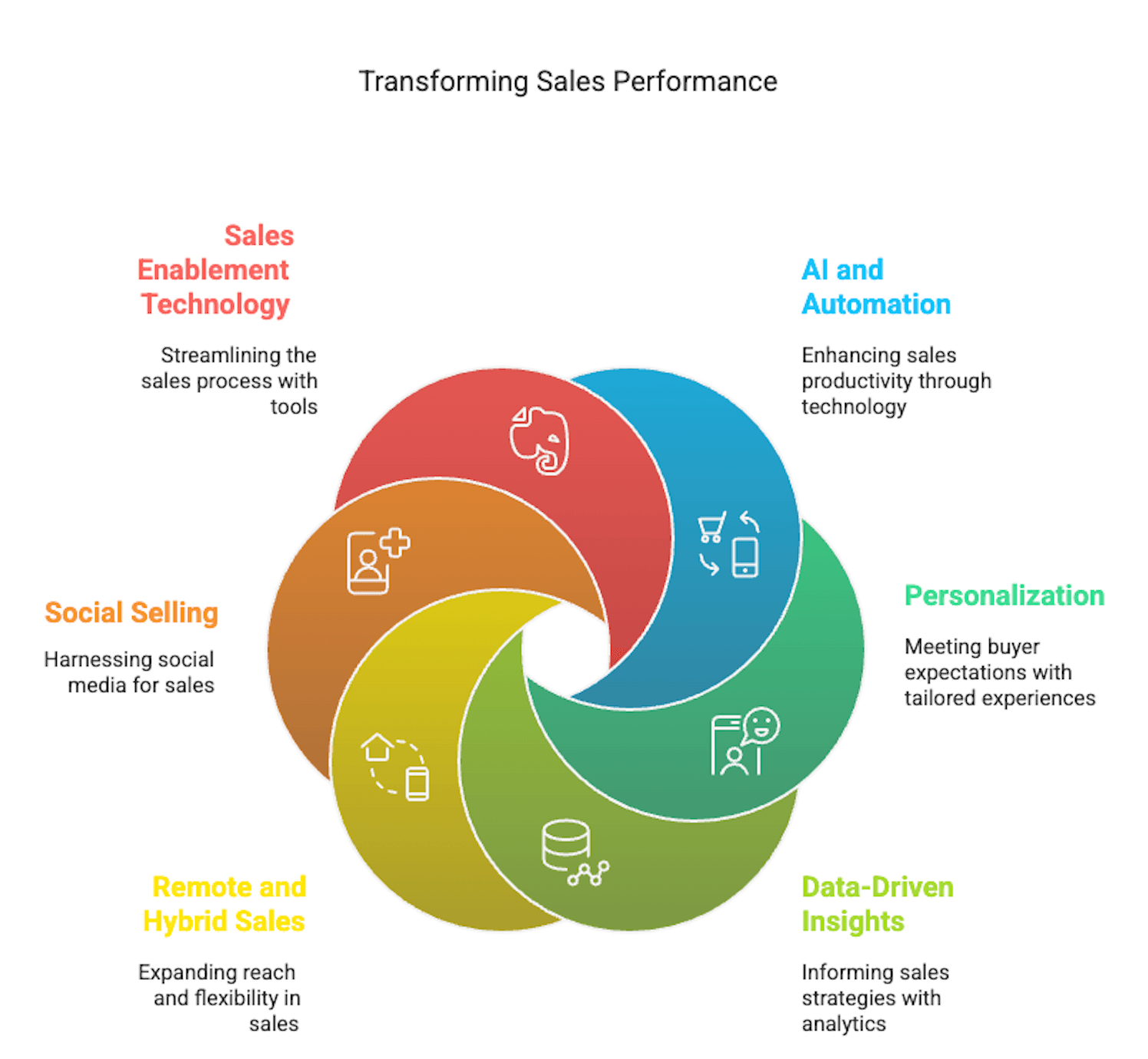
Sales is evolving fast, and in 2025, trends like AI tools and data-driven strategies are redefining how teams engage customers and close deals. Embracing innovation is key to staying ahead.
1. AI and Automation: Supercharging Sales Productivity
Artificial intelligence (AI) and automation have become integral to the sales process, revolutionizing how sales teams manage leads, engage prospects, and close deals. Salespeople can now use AI to predict which deals are most likely to close, reducing manual administrative tasks and allowing them to prioritize their time effectively. Automated follow-ups, CRM updates, and data entry tasks allow reps to spend more time focusing on high-value activities, like building relationships and negotiating deals.
Impact on sales performance:
Higher conversion rates due to more targeted lead nurturing
Reduced administrative workload, increasing rep productivity
More accurate forecasting and better alignment with revenue targets
2. Personalization at Scale: Meeting Buyer Expectations
Today’s buyers expect tailored, personalized experiences at every stage of the buying process, fostering buyer engagement. Emerging trends in sales enablement are making it easier for sales teams to create personalized messaging and content for each buyer, even at scale.
AI-driven content recommendations, dynamic email sequences, and personalized outreach based on past interactions are enabling salespeople to craft more relevant pitches, leading to better engagement and stronger relationships, ultimately enhancing overall performance.
Impact on sales performance:
Increased customer trust and satisfaction due to tailored communication
Higher engagement rates and shorter sales cycles
Stronger competitive advantage with personalized experiences
3. Data-Driven Insights: Informing Sales Strategies
The rise of data analytics and reporting tools has empowered sales teams to make smarter decisions based on real-time data, including metrics like quota attainment and sales cycle length. By leveraging data on customer behavior, preferences, and past interactions, sales teams can develop highly targeted strategies that resonate with prospects. Sales leaders are also using data to track individual rep performance, identify areas for improvement, and ensure their teams are constantly refining their approaches.
Impact on sales performance:
More effective sales strategies based on accurate data
Better decision-making through performance tracking and insights
Enhanced ability to measure ROI on sales enablement tools and programs
4. Remote and Hybrid Sales: Expanding Reach and Flexibility
The shift toward remote work and hybrid work has had a profound effect on sales teams. In 2025, more sales professionals are working remotely than ever before, which means new tools, communication strategies, and collaboration methods, such as digital sales rooms, are essential.
Video conferencing, virtual demos, and collaborative platforms are enabling sales teams to reach prospects across the globe, without the need for face-to-face meetings. This flexibility also allows teams to work across time zones, increasing opportunities for sales.
Impact on sales performance:
Broader market reach through virtual channels
More flexible work environments leading to higher morale and job satisfaction
The ability to connect with international clients more easily
5. Social Selling: Harnessing the Power of Social Media
Social selling continues to grow in importance as a key driver of sales performance. With more buyers conducting research on social platforms, sales teams are using social media to engage directly with prospects.
Sales reps are leveraging LinkedIn, Twitter, and other social networks to build relationships, share valuable insights and content, and gain insights into buyer interests and pain points. This trend has led to a more organic, relationship-based approach to selling, rather than relying solely on cold calling or email outreach.
Impact on sales performance:
Enhanced prospecting capabilities through social media engagement
Stronger relationships built on trust and shared content
Increased opportunities to connect with decision-makers
6. Sales Enablement Technology: Streamlining the Sales Process
Sales enablement tools are transforming how sales teams interact with prospects, including supporting new sales hires. From content management systems that deliver the right materials at the right time to AI-driven sales coaching platforms that provide real-time feedback, these tools are helping reps stay organized, productive, and successful with relevant content. The integration of these technologies into everyday workflows ensures that salespeople have everything they need to make informed decisions, close deals faster, and increase overall sales performance.
Impact on sales performance:
Better sales organization and communication through integrated tools
Increased deal velocity and pipeline efficiency
Continuous improvement of sales skills through real-time feedback
Drive Better Results with Interactive Demos Powered by SmartCue
SmartCue is revolutionizing the way businesses engage potential buyers by offering interactive product demos that increase lead qualification and conversion rates. Instead of relying on passive content like videos or static presentations, SmartCue empowers teams to create highly personalized, hands-on demos that grab attention and drive action.
Why SmartCue?
Personalized Demos: Tailor your demos for specific customer segments, ensuring relevance and increased engagement.
Fast, Scalable Creation: Create impactful demos in minutes with SmartCue’s intuitive platform.
Enhanced Engagement: Interactive demos capture 90% more attention compared to traditional content.
SmartCue is the tool that brings product features to life, streamlining sales cycles and boosting conversions with ease. Start transforming your demos today with a 14-day free trial.
Conclusion
Sales enablement is an evolving field that offers numerous opportunities to enhance your sales strategies, implement innovative practices, and improve your overall selling prowess through effective sales enablement strategies. Stay informed about changes and updates in the sales landscape to make strategic decisions that align with your business goals.
Frequently Asked Questions
What are Sales Enablement tools, and how do they work?
Sales enablement tools are comprehensive platforms that provide visibility across the sales content, training, and coaching lifecycle. They streamline the sales process by offering features such as content management, email marketing, training modules, and analytics that can be leveraged for optimizing strategies, leading to revenue growth.
How can companies adapt to the rapid evolution of sales trends?
Companies can adapt to the rapid evolution of sales trends by staying abreast of the latest market insights, investing in ongoing team training, and fostering a culture of innovation and adaptability within the sales team to enhance customer service and experience.
What benefits does AI offer in Sales Enablement?
AI offers numerous benefits in sales enablement by automating routine tasks and providing real-time feedback. It saves significant time for sales reps that can be utilized for engaging with clients, thereby potentially increasing sales.
How do gamification strategies enhance sales team performance?
Gamification strategies make everyday sales tasks exciting. This motivation technique uses leaderboards, badges, and rewards to instill healthy competition, enhancing morale and performance among team members.
